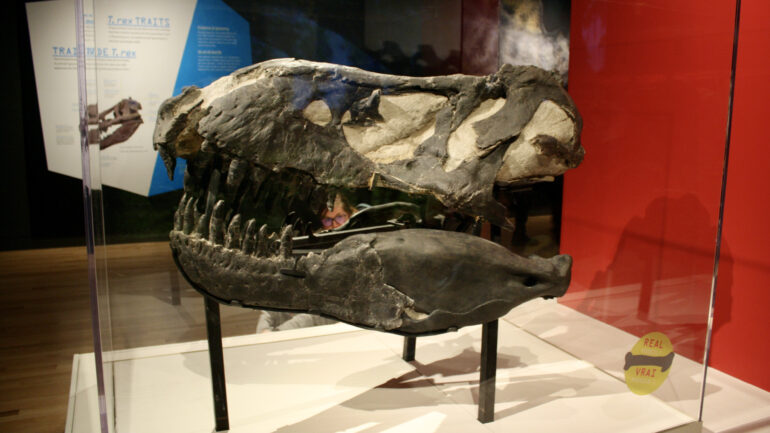About 66 million years ago, a 4.5- to seven-tonne carnivorous dinosaur preyed upon every large creature that lived on the ocean-split landmasses that would become North America.
The Royal Ontario Museum in downtown Toronto is displaying more than 40 models and casts, including full-sized ones, of the deadly Tyrannosaurus rex that once roamed the continent have been reconstructed for a special show, T. rex: The Ultimate Predator.
The exhibition, sponsored by the Desjardins Group, also features real fossils of the ancient predator, all of which were found in Canada.
In a ROM media release, the museum stated its aim is to have the exhibit “thrill and engage all who dare enter.”

A real Tyrannosaurus rex skull fossil, with sections of its jaw being replicated. The display is part of the Royal Ontario Museum's exhibit, T. rex: The Ultimate Predator, which runs until September. Photo credit: Julian Arwen
“With its dynamic blend of skeletons, life-like models, and digital experiences, T. rex rekindles a childlike awe for a ferocious hunter that has long loomed large in the public consciousness,” said ROM CEO and Director Josh Basseches in the press release.
Among the Items at the showcase were models of the T. rex in various stages of its life.
The models depict it from a small, almost unrecognizable infant to a moderately sized theropod to a titanic life-sized model showing how truly large the predator might have been when alive.
In front of the life-like statue is a skeleton of a full-sized T. rex with its shadow on the floor. However, thanks to the projectors above it, the shadow comes to life, as if the prehistoric ghost of the dead dinosaur haunts the room.
However, the skeleton is not a real fossil, but there are fossils of the beast throughout the exhibit.
A real fossil includes the skull of an adult Tyrannosaurus rex, with portions of its lower jaw missing and somewhat warped on the upper right area. Other examples include parts of skulls of younger specimens and vertebrae.
The exhibit also celebrates other Tyrannosaur species, such as the Asian T. rex variant Tarbosaurus, or Canada’s own Albertosaurus, with some displayed as wall art depicting the size of each species in comparison to each other and humankind.
Dr. David Evans, a University of Toronto professor and ROM Temerty Chair in Vertebrate Paleontology said some of the best tyrannosaur skeletons ever found come from western Canada, which was “home to a diverse group of tyrannosaurs, including T. rex, between 80 and 66 million years ago.
“Western Canada is still one of the best places to go Tyrannosaur hunting today, and we are excited to show off some jaw-dropping Tyrannosaur fossils from Alberta in this exhibition,” Evans said in the press release.
The exhibition continues until Sept. 4, 2023.

